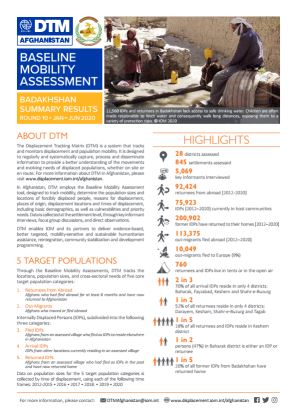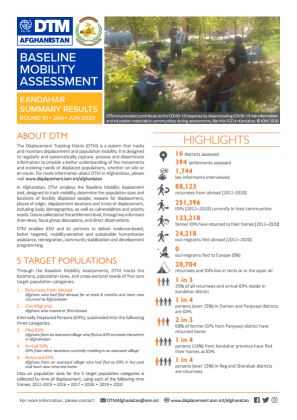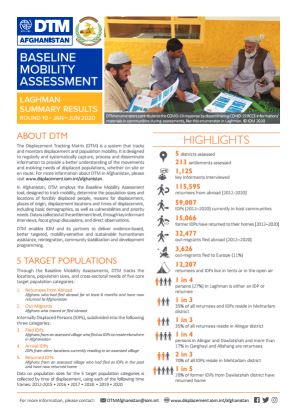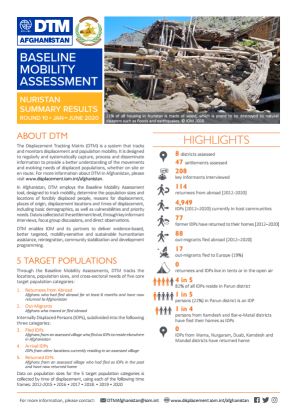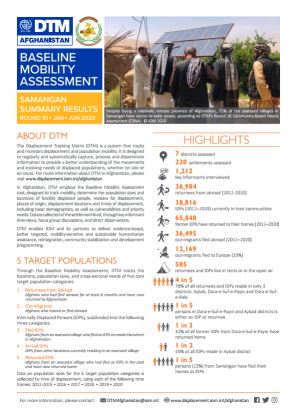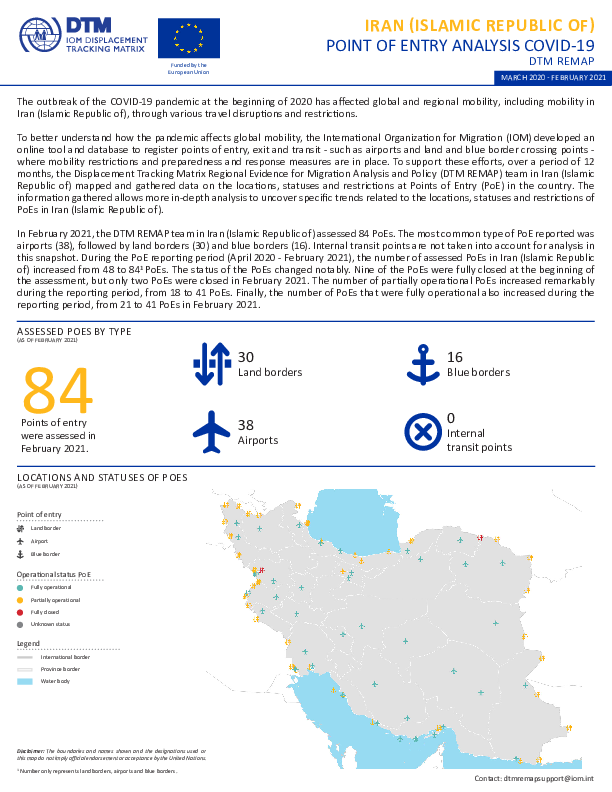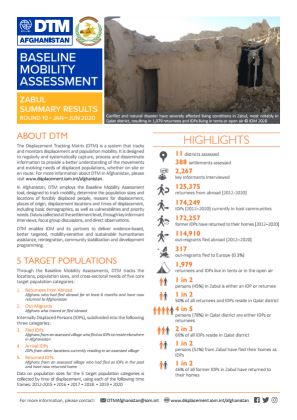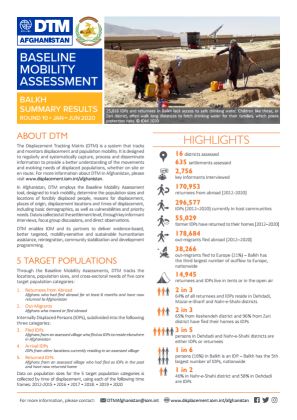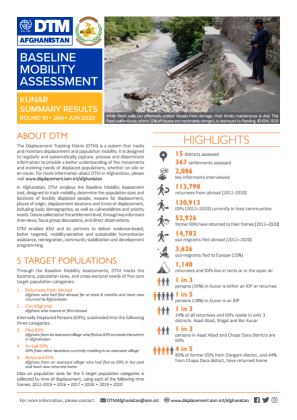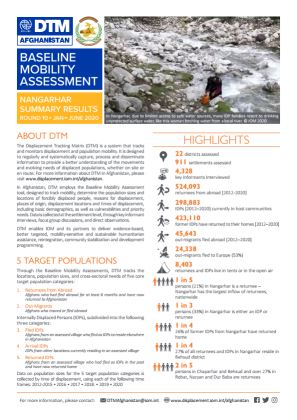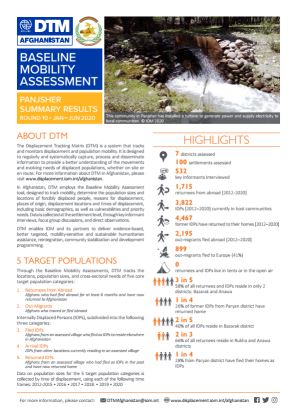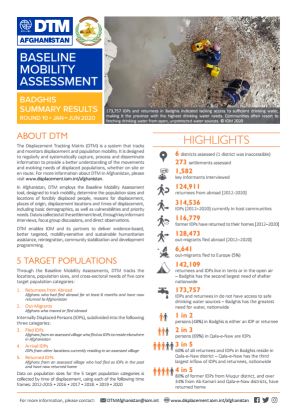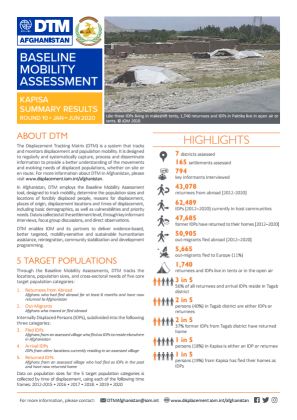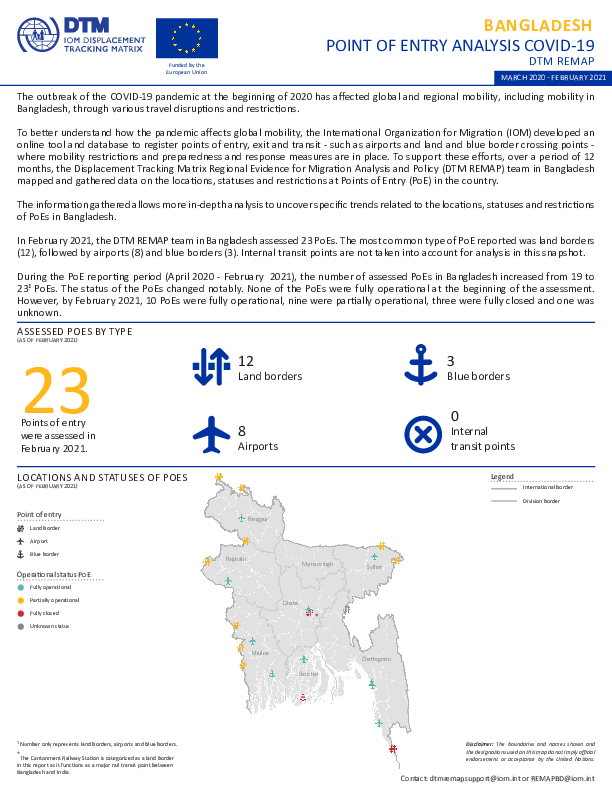-
Countries
-
Data and Analysis
-
Special Focus
-
Crisis Responses
Asia and the Pacific
DTM Asia and the Pacific
DTM Operations in the region
- Active DTM operation
- Past DTM operation
Para obtener resultados de búsqueda más avanzados, vaya a la Página de búsqueda avanzada de informes
BMA R10 — Afghanistan — Badakhshan Baseline Mobility Assessment Summary Results (January—June 2020)
In Afghanistan, DTM employs the Baseline Mobility Assessment tool, designed to track mobility, determine the population sizes, locations and geographic distribution of forcibly displaced, return and migrant populations, reasons for displacement, places of origin, and times of displacement, as wel
BMA R10 — Afghanistan — Daykundi Baseline Mobility Assessment Summary Results (January—June 2020)
In Afghanistan, DTM employs the Baseline Mobility Assessment tool, designed to track mobility, determine the population sizes, locations and geographic distribution of forcibly displaced, return and migrant populations, reasons for displacement, places of origin, and times of displacement, as wel
BMA R10 — Afghanistan — Ghor Baseline Mobility Assessment Summary Results (January—June 2020)
In Afghanistan, DTM employs the Baseline Mobility Assessment tool, designed to track mobility, determine the population sizes, locations and geographic distribution of forcibly displaced, return and migrant populations, reasons for displacement, places of origin, and times of displacement, as wel
BMA R10 — Afghanistan — Kandahar Baseline Mobility Assessment Summary Results (January—June 2020)
In Afghanistan, DTM employs the Baseline Mobility Assessment tool, designed to track mobility, determine the population sizes, locations and geographic distribution of forcibly displaced, return and migrant populations, reasons for displacement, places of origin, and times of displacement, as wel
BMA R10 — Afghanistan — Laghman Baseline Mobility Assessment Summary Results (January—June 2020)
In Afghanistan, DTM employs the Baseline Mobility Assessment tool, designed to track mobility, determine the population sizes, locations and geographic distribution of forcibly displaced, return and migrant populations, reasons for displacement, places of origin, and times of displacement, as wel
BMA R10 — Afghanistan — Nuristan Baseline Mobility Assessment Summary Results (January—June 2020)
In Afghanistan, DTM employs the Baseline Mobility Assessment tool, designed to track mobility, determine the population sizes, locations and geographic distribution of forcibly displaced, return and migrant populations, reasons for displacement, places of origin, and times of displacement, as wel
BMA R10 — Afghanistan — Samangan Baseline Mobility Assessment Summary Results (January—June 2020)
In Afghanistan, DTM employs the Baseline Mobility Assessment tool, designed to track mobility, determine the population sizes, locations and geographic distribution of forcibly displaced, return and migrant populations, reasons for displacement, places of origin, and times of displacement, as wel
Point Of Entry (PoE) – COVID-19 – Dashboard For The Islamic Republic Of Iran (March 2020-February 2021)
The outbreak of the COVID-19 pandemic at the beginning of 2020 has affected global and regional mobility, including mobility in Iran (Islamic Republic of), through various travel disruptions and restrictions.
BMA R10 — Afghanistan — Zabul Baseline Mobility Assessment Summary Results (January—June 2020)
In Afghanistan, DTM employs the Baseline Mobility Assessment tool, designed to track mobility, determine the population sizes, locations and geographic distribution of forcibly displaced, return and migrant populations, reasons for displacement, places of origin, and times of displacement, as wel
BMA R10 — Afghanistan — Balkh Baseline Mobility Assessment Summary Results (January—June 2020)
In Afghanistan, DTM employs the Baseline Mobility Assessment tool, designed to track mobility, determine the population sizes, locations and geographic distribution of forcibly displaced, return and migrant populations, reasons for displacement, places of origin, and times of displacement, as wel
Pakistan - Flow Monitoring of Undocumented Afghan Returnees from Pakistan (14 - 27 March 2021)
IOM Pakistan collects data on the outflows of undocumented Afghan migrants at the Torkham and Chaman border crossing points in an effort to better understand the migration movements of undocumented Afghan migrants returning to Afghanistan from Pakistan.
BMA R10 — Afghanistan — Jawzjan Baseline Mobility Assessment Summary Results (January—June 2020)
In Afghanistan, DTM employs the Baseline Mobility Assessment tool, designed to track mobility, determine the population sizes, locations and geographic distribution of forcibly displaced, return and migrant populations, reasons for displacement, places of origin, and times of displacement, as wel
BMA R10 — Afghanistan — Kunar Baseline Mobility Assessment Summary Results (January—June 2020)
In Afghanistan, DTM employs the Baseline Mobility Assessment tool, designed to track mobility, determine the population sizes, locations and geographic distribution of forcibly displaced, return and migrant populations, reasons for displacement, places of origin, and times of displacement, as wel
BMA R10 — Afghanistan — Nangarhar Baseline Mobility Assessment Summary Results (January—June 2020)
In Afghanistan, DTM employs the Baseline Mobility Assessment tool, designed to track mobility, determine the population sizes, locations and geographic distribution of forcibly displaced, return and migrant populations, reasons for displacement, places of origin, and times of displacement, as wel
BMA R10 — Afghanistan — Panjsher Baseline Mobility Assessment Summary Results (January—June 2020)
In Afghanistan, DTM employs the Baseline Mobility Assessment tool, designed to track mobility, determine the population sizes, locations and geographic distribution of forcibly displaced, return and migrant populations, reasons for displacement, places of origin, and times of displacement, as wel
BMA R10 — Afghanistan — Uruzgan Baseline Mobility Assessment Summary Results (January—June 2020)
In Afghanistan, DTM employs the Baseline Mobility Assessment tool, designed to track mobility, determine the population sizes, locations and geographic distribution of forcibly displaced, return and migrant populations, reasons for displacement, places of origin, and times of displacement, as wel
BMA R10 — Afghanistan — Badghis Baseline Mobility Assessment Summary Results (January—June 2020)
In Afghanistan, DTM employs the Baseline Mobility Assessment tool, designed to track mobility, determine the population sizes, locations and geographic distribution of forcibly displaced, return and migrant populations, reasons for displacement, places of origin, and times of displacement, as wel
BMA R10 — Afghanistan — Farah Baseline Mobility Assessment Summary Results (January—June 2020)
In Afghanistan, DTM employs the Baseline Mobility Assessment tool, designed to track mobility, determine the population sizes, locations and geographic distribution of forcibly displaced, return and migrant populations, reasons for displacement, places of origin, and times of displacement, as wel
BMA R10 — Afghanistan — Kapisa Baseline Mobility Assessment Summary Results (January—June 2020)
In Afghanistan, DTM employs the Baseline Mobility Assessment tool, designed to track mobility, determine the population sizes, locations and geographic distribution of forcibly displaced, return and migrant populations, reasons for displacement, places of origin, and times of displacement, as wel
Bangladesh – COVID-19 Points of Entry Analysis (March 2020 - February 2021)
The outbreak of the COVID-19 pandemic at the beginning of the year has affected global and regional mobility, including mobility in Bangladesh, through various travel disruptions and restrictions.
Rapid Assessment: COVID-19 Related Vulnerabilities and Perceptions of Myanmar Migrants in Mae Sot District, Tak Province, Thailand (March 2021)
From 11 to 22 January 2021, IOM surveyed 316 Myanmar migrants in the Mae Sot district of Tak province in order to better understand their situation and vulnerabilities following the outbreak of COVID-19 in Thailand.
Pakistan — Flow Monitoring Of Undocumented Afghan Returnees From Pakistan (28 February – 13 March 2021)
IOM Pakistan collects data on the outflows of undocumented Afghan migrants at the Torkham and Chaman border crossing points in an effort to better understand the migration movements of undocumented Afghan migrants returning to Afghanistan from Pakistan.
Pakistan — Flow Monitoring of Undocumented Afghan Returnees from Pakistan (14 – 27 February 2021)
IOM Pakistan collects data on the outflows of undocumented Afghan migrants at the Torkham and Chaman border crossing points in an effort to better understand the migration movements of undocumented Afghan migrants returning to Afghanistan from Pakistan.
Bangladesh – Rapid Needs Assessment 2 (August - September 2020)
As the COVID-19 pandemic emerged globally, migrant workers, both internationally and within Bangladesh, found themselves facing a new set of challenges and vulnerabilities.
Pagination
Para obtener resultados de búsqueda más avanzados, vaya a la Página de búsqueda avanzada de conjuntos de datos
Pagination
- First page
- Previous page
- 1
- 2
- 3
- 4
- 5
- 6
Pagination
- First page
- Previous page
- 1
- 2
- 3
- 4
- 5
- 6
- 7
